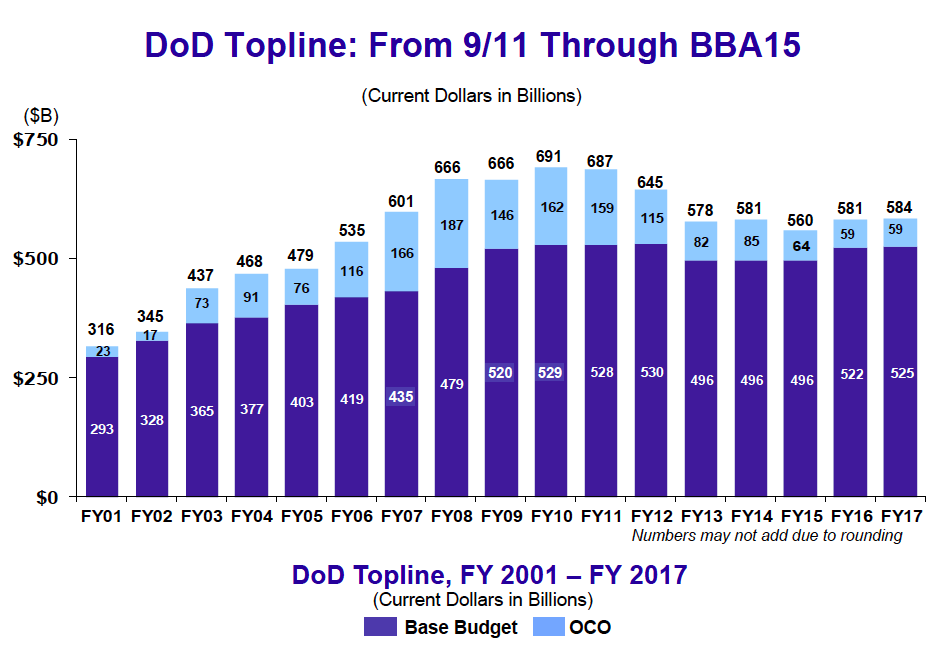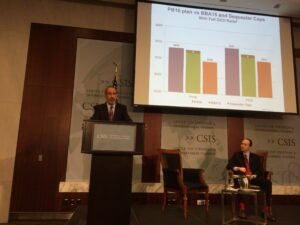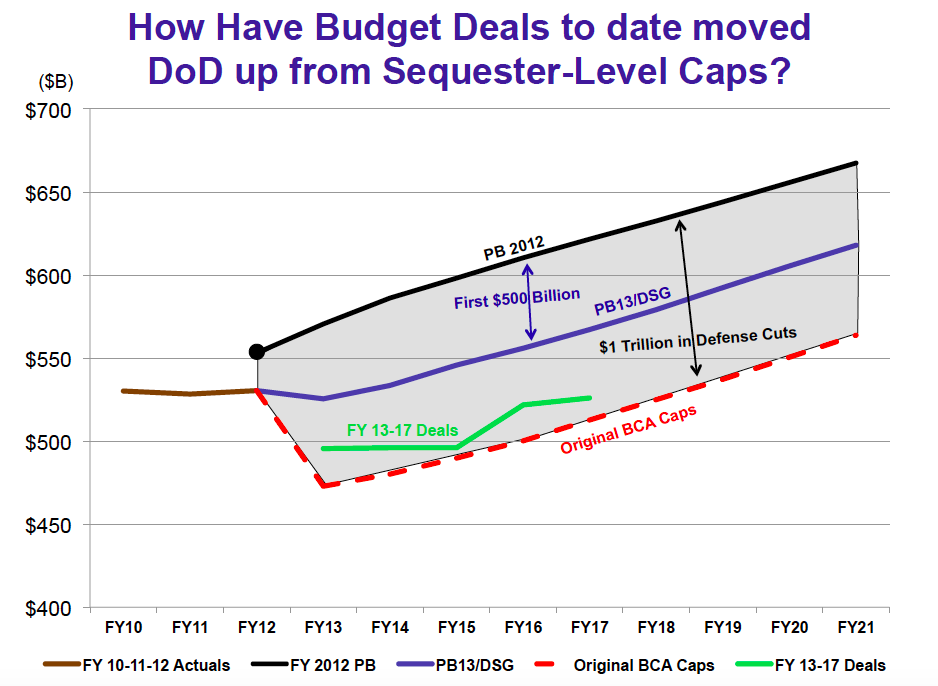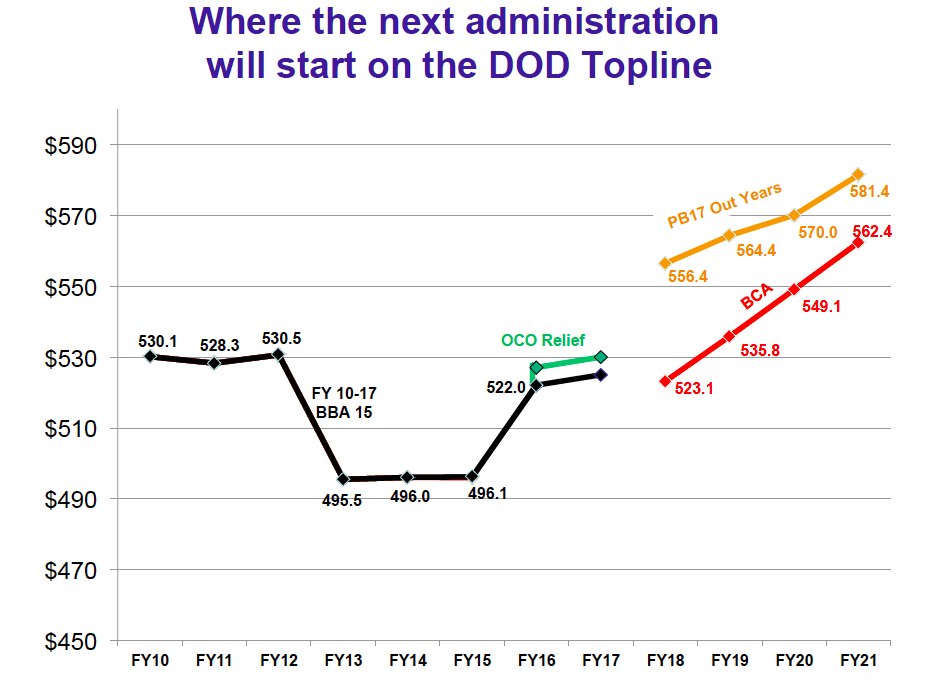McCord: Weapons Slowdowns Coming In 2017’s $584B Budget
Posted on

(from Pentagon comptroller McCord’s presentation today at CSIS)
WASHINGTON: With the Pentagon’s big budget plan for 2017-2021 less than three weeks from completion, Defense Department comptroller Mike McCord promised significant slowdowns in “some” weapons programs, specifically including the Long-Range Strike Bomber.
McCord’s slides pegged the total 2017 defense request at $584 billion ($525 in the base budget and $59 in overseas contingency operations funds). But he cautioned the audience that he hasn’t yet gotten final guidance (known as “pass-backs”) from the White House’s Office of Management and Budget. In a normal year OMB would have issued its verdict on the Monday after Thanksgiving, but there’ve not been many normal years for budgeteers since 2011, so McCord doesn’t expect pass-backs until next Monday.
The total figure available for Defense Department spending is almost completely determined by October’s budget deal. (The deal set a cap for all national security spending, including large parts of the Department of Energy, so its figures don’t translate directly into a DoD budget). And the 2017 figure agreed to in October’s budget deal is effectively $15 billion below what the Pentagon had planned.
Weapons spending will be the target of many cuts because the size of the force, its compensation, and its readiness are all largely off limits, McCord said. That concentrates the impact of a relatively modest cut — $15 billion out of almost $600 billion — on some of the military’s highest-profile and highest-priority investments for the long term.
“One of the ways that we’ll accommodate this $15 billion or so cut is there’ll probably be some slowdowns in some modernizations programs,” McCord said this morning at the Center for Strategic and International Studies. One of those programs will be the Long-Range Strike Bomber, he said, simply because the program was already running late and couldn’t spend money as fast as originally projected.

Michael McCord, DoD comptroller, at the Center for Strategic & International Studies. CSIS’s Todd Harrison is at right.
Even a 6- to 12-month delay in the bomber program could save big dollars in 2017 and the following few years, CSIS moderator Todd Harrison told reporters after McCord’s talk. LRSB is a top Pentagon priority and scheduled to ramp up rapidly once it starts. Another program in a rapid ramp-up is F-35 Joint Strike Fighter production, but McCord demurred when Harrison asked him whether F-35 would be one of the affected programs.
McCord did rule out significant cutbacks to the size of the armed forces, particularly the Army, which is the normal target of such proposals. “I would not expect any major changes in the size of the force because… a short-term deal doesn’t really give you the demand signal,” he said. Force cuts are very difficult without a “clear imperative,” and the long-term budget situation is anything but clear.
Nor is military readiness negotiable, McCord said. The military won’t skimp on near-term training, maintenance, and operations funding to free up funds for long-term investments.
Pentagon leaders have sought savings on military compensation. They may even have gotten some in the recently enacted National Defense Authorization Act — the actuaries are still working out the impact of retirement reforms, McCord said — but the near-term impact will be on the margins.
That does not mean the comptroller is complaining. This deal “is more relief sooner and a better deal overall for us than Murray-Ryan was,” McCord said. Comparing the final DoD budget to what the president requested, “under this deal we got about 98 percent of what we were asking for in ’16,” or 99 percent factoring in some OCO provisions. McCord said. “For ’17 it’s a less little less,” maybe 96 to 97 percent.
That’s up to 98 percent of the Pentagon’s relatively limited goals in its budget plan for fiscal year 2016, it’s worth noting. Compared to the budget plan for 2012, which predated both Robert Gates‘s cuts and the Budget Control Act, the Pentagon will be almost a trillion dollars smaller than originally planned in 2011 by the end of 2021.

(from Pentagon comptroller McCord’s presentation today at CSIS)
McCord acknowledged that Congress has always enacted more money than the Budget Control Act caps. But it does so after agonizing, disruptive last-minute negotiations which make it impossible for the pentagon to plan ahead. Nor does it ever get too far above the BCA caps — which exert a powerful “gravitational pull,” McCord said — certainly never as high as the president’s request. In his decades of defense experience in Washington, McCord said, “that the Democratic president’s position is the high-water mark, that’s a little different.”
For the outyears — 2018 through 2021 — McCord’s slides showed the Pentagon is planning to prose a level of spending well above the Budget Control Act caps. But that will be a question for the next presidential administration and, McCord noted, probably another comptroller.

(from Pentagon comptroller McCord’s presentation today at CSIS)
Mr. McCord’s complete slides follow below, courtesy of his staff and CSIS:
Subscribe to our newsletter
Promotions, new products and sales. Directly to your inbox.
